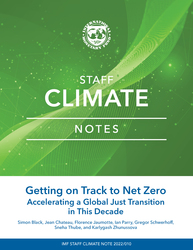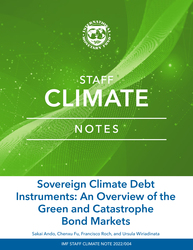
Destination Net Zero: The Urgent Need for a Global Carbon Tax on Aviation and Shipping
Pricing emissions from international aviation and maritime could kick-start the sectors’ transition to net zero emissions while raising up to $200 billion a year in revenues by 2035, which could be allocated to climate finance or other uses.
READ MORE...
Volume/Issue:
Volume 2024
Issue 003
Publication date: October 2024
ISBN: 9798400290244
$5.00
Add to Cart by clicking price of the language and format you'd like to purchase
Available Languages and Formats
| English |
Prices in red indicate formats that are not yet available but are forthcoming.
Topics covered in this book
This title contains information about the following subjects.
Click on a subject if you would like to see other titles with the same subjects.
Taxation - General , Environmental Economics , Environmental Conservation and Protection , Aviation- General , Aviation , maritime , net zero , climate mitigation , carbon pricing , feebates , instrument choice , design issues , administration , International Civil Aviation Organization , International Maritime Organization , IMF staff Climate note , part of the International Monetary Fund , IMF analysis , IMF staff Climate , IMF Staff Notes Series , Carbon tax , Greenhouse gas emissions , Energy conservation , Global , Climate finance
Also of interest
Summary
The need to decarbonize international aviation and maritime has long been overlooked. The two sectors account for a small but rapidly growing share of global CO2 emissions, and could rise to as much as 15 to 40 percent by 2040. Pricing these emissions could help global climate policy in two ways. First, it could accelerate technological development while incentivizing efficiency, kick-starting the sectors’ transition to net zero while addressing the sectors’ hitherto favorable tax treatment. Second, pricing could raise up to $200 billion a year in revenues by 2035, which could be allocated to climate finance or other uses. There are significant political obstacles, however, notably reaching consensus on revenue allocation and managing price impacts, which are substantive for flight tickets but less so for shipped goods. Pricing variants, like ‘fee and rebate’ schemes (feebates), have lower price impacts but raise fewer revenues. This paper discusses these policies, using a new model to quantify impacts on fuel use, emissions, revenues, production and economic costs, and on vulnerable states..
Copyright © 2010 - 2025
Powered by:
AIDC



